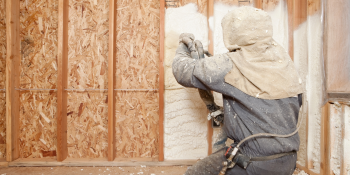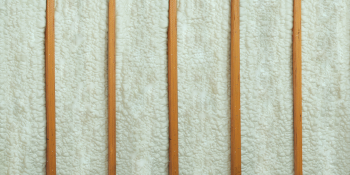Q&A Forums
Open or Closed on Roof Deck??? Post New Topic | Post Reply
| Author | Comments |
|---|---|
|
Posted: Jun 23, 2009 01:49 PM
|
Open or Closed on Roof Deck???
I am asking this question as a homeowner ready to have my roof deck spray foamed (assuming I can get the bloody price at a reasonable level). All the spf contractors here (Hattiesburg, MS) recommend open cell in case there is a water leak (Icynene dealers obviously since that's all they make). From the research I've done the forums seem to be divided. One manufacturer I talked to said they recommended closed cell because you'd still eventually see the water leak anyway as it would migrate to the 1st decking joint and eventually find it's way along the rafter and down into the attic. This seems to be flawed logic to me. If the closed cell is completely sealed to the side of the rafter (after all we are statically sealing the attic area in), how would water get past it without 1st rotting out the rafter. The water issue to me is how quickly can you detect and repair. Anyway I would appreciate some help here so I can make an informed decision. Closed cell seems to be a superior product, especially if it's gas blown. FYI, this is an old 1916 historic home with the handlers and duct work in the attic. As a quick side question I can't seem to find any useful information on how to treat the enclosed space in the Manual J calcs. I would think the overall load requirements would be reduced by enclosing the space and reducing heat gain/loss but some or all of this space is now part of the conditioned space. |
|
mason
Posted: Jun 23, 2009 09:24 PM
|
This is a marketing theory that is largely a myth. In my almost 40 years in the industry I have yet to see a specific example of this happening. The closed cell foam will seal cracks and crevices in the sheathing preventing leaks from getting in the building. The water stays on top of the decking and gravity takes it to the edge of the building. Water could get in through penetrations that have not been flashed properly but in that case the water would enter the building and be noticed. some of the advantages of open cell foam: Open cell foam will cost less per R value than closed cell foam and has better sound absorbing properties. In cases where the foam has be removed, open cell foam is much easier to remove. Please check out my website masonknowles.com for articles on Learning the Difference Between 1/2 lb and 2 lb SPF and my RCI articles on SPF myths. Don't worry about treating the attic as conditioned space. Ignore it and just use the inhabited space for calcuations. The natural air infiltration from the inhabited space will heat or cool the area without having to account for the extra space. This makes it much more energy efficient particularly if you have ductwork in the attic. Just make sure the HVAC guys calculate the lower amount of air infiltration so that they do not make the AC and furnace too large and to make sure they have sufficient make up air for the building. |
|
Terry Adams
Posted: Jun 23, 2009 11:42 PM
|
Myth and marketing tool is exactly right. A lot of what some spray foam guys will say flys right in the face of logic. |
|
Posted: Jun 24, 2009 10:18 AM
|
Thanks Mason. FYI, my decking happens to be tongue and groove heart pine (water does not damage heart pine quickly) and I am in Hattiesburg MS, about 100 miles from the Gulf Coast and 130 miles from New Orleans. It sounds like you are recommending open over closed for a roof deck application. Sound absorbtion is probably not a high priority since this is an old historic home. What are the other advantages/disadvantages of each? It looks like sound/water/cost are the primary considerations assuming the same r-value is achieved for each?? After looking at your articles, it's not clear whether a vapor barrier would be required??? Also, if I use open cell and do have a roof leak (Katrina came thru here and I had to replace my roof then) and portions of the open cell have to be removed and replaced, how is that done? At what expense would the spf contractor have to come out and respray those areas, or do they have portable equipment they can use for those applications? Thanks, David |
|
mason
Posted: Jun 28, 2009 10:55 AM
|
I am not recommending open cell or closed cell. But I thought you would want to know the specific advantges of open cell that is not marketing hype. An advantage of the closed cell foam that you may not have considered. That close to the coast you are still likely to get hurricane force winds a few times in a 15 to 20 year time span. Closed cell foam installed under the roof sheathing will help hold that deck in place in case of a big blow. Research conducted at the University ofFlorida's Hurricane Research Center showed that installing 3 inches of close cell foam between the rafters increases the decks wind uplift resistance 3 times and just spraying a picture frame filet around the framing members increases the wind uplift resistance of the deck by 2 times. I have performed extensive research on roofing systems and buildings while a member of the Roofing Industry's Committee on Weather Issues investigating hurricane damage from Hurricane Katrina and Hurricane Ike and on my own first as a contractor in South Texas replacing roofs after Hurricane Allen in 1980 and in 2008 investigating damage after Hurricane Dolly. REsults, the application of SPF both inside and outside the building can greatly reduce damage caused by strong winds and interior pressurization. See my articles on the topic at my website, masonknowles.com |
|
mason
Posted: Jun 28, 2009 11:03 AM
|
You can remove the old foam and spray new foam directly tot he substrate. It should adhere to the old foam just fine. Just make sure it is relatively clean and dry with no contaminates that would affect adhesion. I am not aware of portable foam paks that dispense open cell foam. There are portable foam paks that dispense closed cell foam in densities ranging from 1.5 to 2.7 lbs per cubic ft in sizes ranging from 5 lb units to 30 lb units. Check with a foam supplier for details and a list of brands of foam that can be used for this purpose |
|
Michael Fusco
Posted: Jun 28, 2009 03:07 PM
|
God Mason....recommending closed cell foam as a structural member is specifically a violation of code....."closed cell foam will hold your roofing members in place during a big blow"...... |
|
mason
Posted: Jun 28, 2009 08:41 PM
|
Actually I know of two companies who have Florida product approval for the use of the product in this way. |
|
Michael Fusco
Posted: Jun 29, 2009 08:19 AM
|
Any ESR's? |
|
Posted: Jun 29, 2009 09:42 PM
|
You're going to have help me here. What's an esr? Thanks, David |
|
mason
Posted: Jun 30, 2009 04:04 PM
|
ESR refers to a evaluation service report. This is a report that the code body issues to verify that an application, process, material, etc is code compliant and also provides more specific detail of its application. An evaluation report is typically not required for foam plastic insulation if the data sheets show that the physical properties match up to the prescriptive tables of the code and it is covered with a code designated thermal or igniton barrier. (although some code officials want them no matter what) However, if the application is not specifically covered in the codes or if you want an exception to the thermal or ignition barrier rules, an evaluation report is a good the way to obtain approval from a code official. AS for the case of using sprayfoam to the underside of the deck assembly, you can install as an insulation without additional approvals. For example the SPF industry has marketed sprayfoam as a way to stop air infiltration for years as an added benefit to consumers, but until recently there wasn't a specific criteria that the building codes required to designate a material as an air barrier. That has changed now. So, this is kinda the same situation. There is pretty convincing data, but if you wanted to use it in place of a code designated fastening attachment to the deck then an evaluation report would be essential. However if you are marketing the foam as a way to enhance an already code compliant roof deck it is acceptable. And in the case of Florida, two companies have product approval for using their closed cell foam as a structural enhancement to the roof deck assembly. One of the companies that sells foam as an adhesive uses it to hold manufactured housing together and they do have reports for those applications. I expect more states to adopt the use of foam as a structural material as this particular use becomes more well known. Check out my article SPF Beyond Insulation at masonknowles.com for some research both in the lab and in the field on this use for SPF. |
|
Charlie Clark
Posted: Apr 24, 2017 10:02 AM
|
https://www.homelogic.co.uk/icynene-open-cell-and-closed-cell-insulation/ |





























